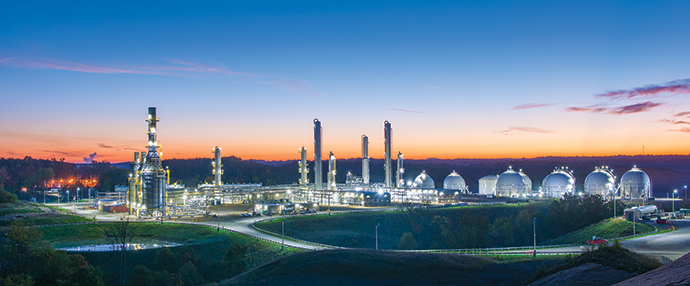Whether a community is directly involved or not, expansion of the shale energy industry in Ohio has far-reaching consequences for statewide economic growth. Regions where the extraction of natural gas and liquid natural gas (LNG) take place are already attracting projects with substantial capital investment and job creation. But the impact of lower energy costs and costs for feedstocks means downstream investment is equally promising.
Marathon Petroleum Corporation (MPC) will celebrate the opening of its new MPLX headquarters facility n September 2016. MPLX was formed by MPC to own, operate, develop and acquire pipeline and other midstream assets. In 2015, MPLX merged with MarkWest, the largest processor and fractionator in the Utica and Marcellus shae plays The MPLX headquarters project will create 150 news jobs. Meanwhile in Western Ohio, the Potash Corporation is also taking advantage of the lower feedstock prices and investing $190 million to expand its ammonia production plant in Lima.
Additionally, several natural-gas-fired power plants are under construction. Oregon Clean Energy is investing $800 million in a facility near Toledo; NTE Energy is building a $645-million plant in Middletown; Advanced Power is building a plant in Northeast Ohio totaling $899 million; and Clean Energy Future is building an $890-million plant in Lordstown.
“Downstream opportunities will bring the long-term investment along with high-paying, long-term jobs,” says Matt Cybulski, director of Shale Energy & Petrochemicals industries for JobsOhio. “These facilities are significant capital investments and have long life spans, and the types of employees they have at these facilities are highly skilled. We see the benefit in that and are working with companies on opportunities. We’re also making sure we identify sites these companies can consider for locations. These types of projects have a really long term economic benefit to the state.”
“Cleveland State University reported in a shale study they conducted that less than 5 percent of the drillable acreage has been drilled,” says Dana Saucier, managing director for the Shale Energy & Petrochemical industry for JobsOhio. The study cited by Saucier also reported that the anticipated production from the Utica and Marcellus Basins “will create a surplus of ethane in the region by 2020, in excess of the takeaway capacity.” That abundance is why leaders in Southeast Ohio banded together in June 2016 to brand the region “Shale Crescent USA.”
“We are the economic engine to bring business to this area for manufacturing,” says Mark Schwendeman, director of Shale Crescent USA. “We want to be the economic development leader of this effort by bringing high energy users to this area.”
Shale Crescent USA is made up of civic leaders, business executives and economic developers from Marietta, Ohio, and Parkersburg, West Virginia. The group wants to get the word out that thanks to historically low prices for natural gas, there’s never been a better time to invest in their corner of Ohio, or anywhere else in the state.
“Virtually all the growth in natural gas is happening in Ohio, West Virginia and Pennsylvania,” says Jerry James, president of Artex Oil Company and one of the leaders of the Shale Crescent initiative. “One-third of all natural gas comes from here. In just a few years, it has driven us to this opportunity to have a resurgence of manufacturing in Ohio. This is a huge opportunity.”
It’s an opportunity too big to miss, or so PTTGC America believes. The company is looking to build a large petrochemical complex — also known as an ethane cracker — in Belmont County’s Mead Township, along the Ohio River. The investment would likely run into the billions of dollars and create hundreds of jobs in the region for skilled workers, such as chemical engineers, chemists, lab technicians and other highly paid employees. PTTGC America is currently engaged in a feasibility study, investing $100 million in the project’s front-end engineering design. A final investment decision is expected by the first quarter of 2017.
Access to talent is an integral part of developing the shale energy industry. JobsOhio recently launched a new Talent Acquisition program to deliver customized workforce solutions for company expansions and companies newly locating in Ohio. In addition to working with companies on the talent plan that will support their operation, the Talent Acquisition team is collaborating with existing state resources and the Governor’s Workforce Transformation team to engage high schools, vocation and trade institutions, community colleges, and four year universities to align programs with in-demand jobs and skills.
There are things a state can influence, like workforce development or maintaining and upgrading infrastructure, and things it can’t, like the location of natural gas reserves. Fortunately for Ohio, it’s got it all. “We have the majority of the wet gas in the Utica, which is what brings all the liquids, propane, ethane, which are attracting some of these clients,” says Saucier. “We’re very excited for the future and the positive impact energy is going to have for Ohio and the region for many decades. As amazing as a transformation the industry has already gone through, our best days are well ahead of us.”

